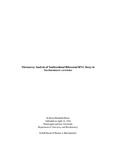Microarray Analysis of Nonfunctional Ribosomal RNA Decay in Saccharomyces cerevisiae (thesis)

View/
Author
Driest, Kathryn Elizabeth
Subject
Washington and Lee University -- Honors in Biochemistry
Saccharomyces cerevisiae
DNA microarrays
Gene expression -- Research
RNA
Metadata
Show full item recordDescription
Thesis; [FULL-TEXT FREELY AVAILABLE ONLINE] Kathryn Elizabeth Driest is a member of the Class of 2014 of Washington and Lee University. Nonfunctional ribosomal RNA decay (NRD) is a eukaryotic degradation pathway that targets and eliminates structurally intact but functionally defective ribosomal RNAs (rRNAs). Two separate NRD pathways for 18S and 25S rRNA have been identified. 18S NRD requires translation elongation and involves the termination factor-like proteins Hbs1p and Dom34p, and the mRNA decay factors Ski7p and Xrn1p. 25S NRD, however, is not dependent on translation elongation and requires the ubiquitin E3 ligase component Rtt101p and its associated protein Mms1p, as well as the ubiquitin-binding Cdc48 complex. Although identification of these factors has provided considerable insight into the degradation pathways, much remains to be uncovered. We have employed DNA microarrays to determine changes in gene expression that occur when defective rRNA substrates that activate NRD are present. These were analyzed with the goal of discovering additional factors involved in NRD. Saccharomyces cerevisiae cells were transformed with galactose-inducible plasmids containing NRD substrates. Activation of NRD was confirmed by RT-qPCR and phenotypic analysis. The mRNA population was then reverse transcribed to cDNA, labeled with fluorescent dyes, and hybridized to the microarray. Comparison of dye intensities allowed for determination of global gene expression changes induced by NRD. Initial data analysis revealed induction of ribosomal protein gene expression as well as rDNA silencing genes. Increased expression of ubiquitin was observed upon activation of 25S NRD, consistent with observations of ubiquitylated 25S NRD substrates. Repression of the deubiquitylation enzyme Otu1p and other RNA processing factors was also observed. Continued analysis of the microarray data and additional verification of potential genes of interest is an ongoing part of this investigation. Kathryn Elizabeth Driest